Hey there, fellow guitar heroes! Ever found yourself shredding a killer solo, only to be stopped by a fret that’s more worn out than a drummer’s sticks after a three-hour gig? Frets, those essential metal ridges on your guitar’s neck, might not get the spotlight, but they’re the backbone of your sound. But how long do guitar frets last? Well, grab your favorite axe, and let’s dive into the rock ‘n’ roll world of fret wear!
You can use the table of contents below to take you to the area that interests you. Click on the little box to open it and then click on the section of the article you want to read, or you can read from start to finish if you want the full guitar fret experience!
The Short Answer
The lifespan of your frets depends on their material and size, the strings you use, your playing style, and how well you care for them. Nickel-silver frets can easily last 5 to 10 years, while stainless steel can work well for three decades or more. Playing techniques like string bending, finger vibrato, and trills can wear down frets faster. Regular cleaning and proper evaluation by fret professionals can help keep your frets in good condition.
Keep On Reading (Below) To Learn More
Understanding Guitar Frets
If you already know the basics, skip to the next section, and we’ll get on with answering the question.
What Are Guitar Frets?
Guitar frets are the metal strips that divide your guitar’s neck into sections. When you press a string down on the neck at a particular location, it contacts that fret. This effectively shortens the length of the string between the fret and the guitar bridge, thereby changing the pitch of the note.

The frets higher up, toward the guitar’s body, create higher notes and vice versa.
Traditional nickel frets are reliable but can wear out if you’re shredding too hard. Stainless Steel frets are tougher, last longer, and are perfect for those power chords. Gold frets look cool, but some brands might not be the most durable option.
Why Fret Wear Happens
Ever wonder why your frets start to look like they’ve been on a world tour without you? Playing habits can wear them down, especially if you play like Slash every day. The string material also matters. Some strings are harder on the frets than others.
And don’t forget environmental factors like humidity and temperature, which can oxidize and loosen your frets over time.
How Long Do Guitar Frets Last?
The lifespan of guitar frets is a question that resonates with every guitarist, from the casual strummer to the touring professional. It’s a complex issue, influenced by a variety of factors. Let’s explore this intricate subject.
Material Matters
Frets are typically made from various materials, each with its unique wear characteristics. The choice of fret material can significantly impact the longevity of the frets.
Here’s a table that estimates the average lifespan of each type of fret material for the average player. Please note that these estimates are based on average playing conditions and can vary widely depending on factors like playing style, frequency, maintenance, and more.
| Fret Material | Average Lifespan (Years) |
|---|---|
| Nickel (Nickel-Silver) | 5-10 |
| Silver | 10-15 |
| Gold | 15-20 |
| Stainless Steel | 20-30+ |
Fret Sizes And How They Affect Fret Wear
Choosing the right fret size is like finding the perfect guitar pick; it’s a personal choice that can affect your playing experience. Understanding the relationship between fret sizes and guitar necks is essential for any guitarist. It helps determine the choice of instrument, playing comfort, and long-term fret wear.
Different fret sizes are commonly found on various types of guitar necks and guitar brands, each offering unique characteristics. From vintage to extra jumbo, fret sizes can affect the feel and sound of your guitar and how quickly they wear down. Let’s explore the main types.
Be aware that when I say wear down “faster,” It’s not because their material is different. Taller frets last longer before they wear down to the point where they begin to cause playing problems and need to be repaired (reshaped) or replaced.
Here’s a table to give you a visual tour of how different fret sizes wear compared to others. As you move down the table in size, the taller and generally the wider the frets become.
These descriptions are very basic generalizations. There are many different fret size and shape specifications among the various manufacturers, who describe them all a little differently!
| Fret Size | Wear Rate | Description |
|---|---|---|
| Vintage | Faster | Smaller, found on vintage-style guitars and reissues, classic feel. |
| Medium | Moderate | Balanced, used on a wide range of guitars, versatile choice. |
| Medium Jumbo | Balanced | Comfortable, commonly found on modern electric guitars. |
| Jumbo | Slower | Unique feel, often used on electric guitars for rock and metal. |
| Extra Jumbo | Even Slower | Very large, found on specialized guitars for virtuoso playing. |
| Custom | Varies | Tailored to player, found on custom-built guitars, unique feel. |
Vintage Frets
Vintage frets are the shortest in height and wear down quickly. They are often found on vintage-style guitars and reissues, providing a classic feel that’s favored by many traditional players.
If you’ve ever played an old Strat or Tele with a curved (7.25 inch) fretboard that makes any chord you play feel great, but the strings are a little difficult to bend with the action set low, it most likely has vintage-size frets.
Medium Frets
Medium frets offer a balanced and versatile experience. They are commonly used on a wide range of guitars, from electric to acoustic, making them a popular choice for various playing styles.
This is the fret size most players are used to. They’re not too short and not too tall. “Just right,” like the Three Little Bears story. They’re probably my favorite fret size, especially for playing the blues.
Most of the newer Fender electric guitar necks with a flatter (9.5 inch) fretboard have medium frets to keep chord playing comfortable but make it easier to bend notes up and down the neck with a low string action,
Medium Jumbo Frets
Medium jumbo frets provide a comfortable playing experience with a balanced wear rate. They are frequently found on modern electric guitars, appealing to players looking for a blend of comfort and durability.
This fret size is for those who find medium too small but jumbo on the large side. As I said above, there is very little standardization among fret manufacturers, so the feel of the frets under your fingers is what you should rely on.
Jumbo Frets
Jumbo frets are known for their unique feel and slower wear rate. They are often used on electric guitars designed for rock and metal, providing a distinct playing experience.
They are usually found on the so-called “Super Strat” guitars designed with necks for lead guitar players, typically brands like Ibanez and Jackson. With the right guitar setup and string gauge, the notes bend like a hot knife through butter!
Extra Jumbo Frets
Extra jumbo frets are even larger and wear very slowly. They are typically found on specialized guitars, such as those designed for virtuoso playing, where a unique feel is desired.
I don’t typically like the feel of extra jumbo frets. For me, they seem a little cumbersome, especially when sliding notes up and down the neck with frets that aren’t well-crowned. It doesn’t mean they’re not suitable for other players. It’s definitely a personal choice.
Custom Sizes
Custom frets are tailored to the specific player and instrument. They can be found on custom-built guitars, where individual preferences and playing styles are taken into consideration.
It’s unlikely that you will ever play a guitar built like this, but if you do, be sure to carefully evaluate the pros and cons of the instrument before you purchase it!
Here’s a chart from Anderson Guitarworks that shows the variation ins fret size names, shapes, and measurements.

Playing Techniques And Frets
The way you play your guitar can have a significant impact on fret wear. Different playing techniques exert varying levels of pressure and friction on the frets, leading to wear over time.
Every guitar player has their signature moves, those techniques that make their sound unique. Let’s explore some common techniques and how they affect fret wear.
Here’s a table that summarizes how different playing techniques affect fret wear.
| Playing Technique | Effect On Fret Wear |
|---|---|
| Hammer-Ons | Increased wear due to forceful contact with the frets; more aggressive usage leads to quicker wear. |
| Pull-Offs | No effect on fret wear; technique involves releasing the string without pressure on the fret. |
| Bending | Wear depends on the distance of the bend; more significant bends exert more pressure on the frets. |
| Finger Vibrato | Moderate wear due to constant string oscillation on the fret; faster vibrato can increase fret wear. |
| Trills | Increased wear due to rapid alternation between notes; involves both hammer-ons and pull-offs. |
| Picking Style | Varies based on the force and type of pick used; aggressive strumming or heavy picks can cause wear. |
Hammer-Ons
Hammer-ons are a technique where a note is played by sharply bringing a finger down on the fretboard. This can cause more wear on the frets, especially if done with force. It’s like a drummer hitting a cymbal – the harder the hit, the more wear it can cause.
Hammer-ons are used in all genres of modern guitar playing to some degree. Some hammer-ons are subtle, while others are quite apparent.
Pull-Offs
Pull-offs are the opposite of hammer-ons, where a finger is pulled off a string, allowing it to vibrate freely. Unlike hammer-ons, this technique doesn’t contribute to fret wear because the finger is being lifted off the fret.
Players that use hammer-ons also use pull-offs. Combining hammer-ons with pull-offs in rapid succession will create a trill.
Bending
Bending a string to reach a different pitch puts pressure on both the string and the fret. The more extreme the bend, the more pressure is exerted, leading to potential wear on the frets. It’s a technique that adds flair to playing but requires attention to the instrument’s care.
Bending strings allows a smooth pitch transition up to the next note on a string. Some bends are less than a half-tone, typically a quarter-tone or even less. Partial bends can give music an “Eastern” flavor.
Finger Vibrato
Finger vibrato involves moving a finger back and forth on a fret to create a vibrating sound. The faster the vibrato, the more it tends to wear the fret, especially on the frets where the technique is frequently used.
Finger vibrato is one of the most unique calling cards of any guitar player because virtually everyone’s vibrato sounds different. For example, compare B. B. King’s vibrato with Eric Clapton’s, and you’ll hear the difference immediately!
Trills
Trills are a rapid alternation between two notes, involving hammer-ons and pull-offs in quick succession. This can lead to increased wear on the specific frets involved in the trilling.
Listen to Tony Iommi’s Black Sabbath solos, who is one of the all-time heavy metal trill-masters!
Picking Style
Different picking styles can also influence fret wear. The force exerted on the strings translates to the frets, affecting their longevity. Whether using a heavy pick or aggressive strumming, the way you pick can shape not only your sound but the life of your frets.
Guitar Strings Matter!
Guitar strings and frets have a relationship that’s as complex as a prog-rock masterpiece.
Different types of guitar strings can either be a gentle caress or a full-on assault on your frets. Let’s break it down and take a look at what’s what.
Here’s a table that summarizes the various types of string materials and the three string winding methods. They are just generalizations since each string manufacturer does things a little differently.
| String Type | Sound Characteristics | Fret Wear Effect |
|---|---|---|
| Pure Nickel Wrap | Soft, warm tone; vintage sound | Mild wear; nickel winding gentle, nickel-plated steel slightly increased wear |
| Pure Nickel | Rich, warm sound | Less wear on frets than pure nickel wrap |
| Nickel-Plated Steel | Balanced tone; brighter than pure nickel wrap | Moderate wear rate |
| Stainless Steel | Bright, cutting tone | High wear due to harder material |
| Coated Strings | Smooth feel, extended lifespan | Reduced friction and fret wear |
| Bronze Strings | Bright sound (varies by alloy) | Varying wear effects depending on alloy |
| Nylon Strings | Mellow tone, favored by classical players | Gentle on frets, no wear |
| Miscellaneous (e.g., Cobalt) | Unique tonal characteristics; varies by type | Wear properties vary; consult manufacturer |
| Round Wound | Bright tone, ridged surface | More fret wear due to increased friction |
| Flat Wound | Mellower sound, smooth surface, used by Jazz players | Reduced fret wear compared to round wound |
| Half Wound (Ground) | Balanced tone comes from mix of round and flat winding techniques | Reduced fret wear compared to round wound |
Pure Nickel Wrap Strings
Pure nickel wrap strings are a unique blend of materials, where the three plain strings are made from nickel-plated steel, and the three lower strings are made from a steel core with a nickel winding.
This combination offers a soft and warm tone, reminiscent of vintage sounds. The nickel winding on the lower strings provides a rich texture, while the nickel-plated steel on the plain strings adds brightness.
The wear characteristics of pure nickel wrap strings are moderate, with the nickel winding being gentle on the frets, while the nickel-plated steel may have a slightly increased wear rate.
Pure Nickel Strings
Pure nickel strings are crafted entirely from nickel, providing a rich and warm sound. Their softer material leads to less wear on the frets, preserving their longevity. They have become a more popular choice over the years.
Nickel-Plated Steel Strings
Nickel-plated steel strings are made by plating each steel string with nickel. They offer a bright and balanced tone, with a moderate wear rate on the frets. They are similar to the pure nickel wrap strings, except the windings on the three lower strings are not pure nickel.
Stainless Steel Strings
Stainless steel strings are known for their bright and cutting tone. Made from stainless steel wire, their harder material can cause increased wear on the frets.
Coated Strings
Coated strings feature a thin polymer coating over the core material, reducing friction and wear on the frets. They provide a smooth feel and extended lifespan for both the strings and the guitar frets.
Bronze Strings
Bronze strings are crafted by winding bronze alloy around a steel core. Commonly used on acoustic guitars, they offer a bright sound, with wear effects varying by alloy.
Nylon Strings
Nylon strings, made from nylon monofilament, are gentle on the frets without wear concerns, and are favored by classical players for their mellow tone.
Winding Methods: Round Wound, Flat Wound, Half Wound
There are essentially three ways that strings are wound. Each method creates a different sound and playing experience on the bass strings, but also affects fret wear.
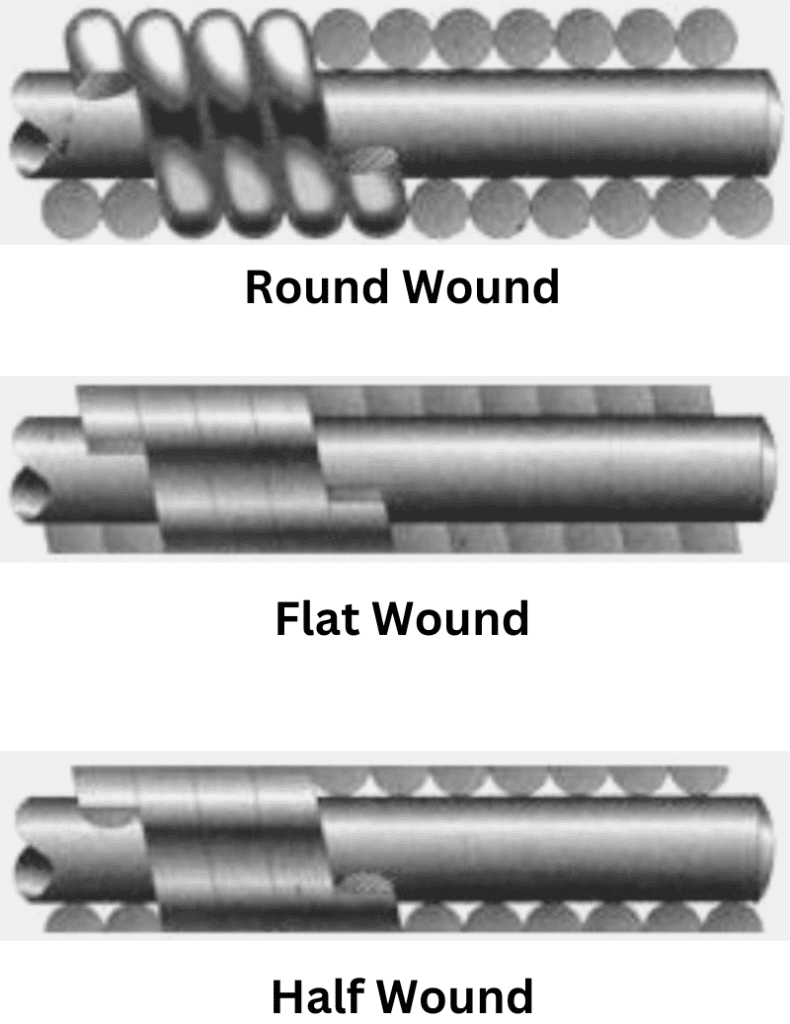
Round Wound Strings
These strings are made by winding round wire around the core, creating ridges. They offer a bright tone but can cause more fret wear due to increased friction.
Flat Wound Strings
Flat wound strings use a flat ribbon wire winding, providing a smoother surface that reduces fret wear. They offer a mellower sound and are often favored by jazz players.
Half Wound Strings
Half wound strings, also known as “ground wound,” are a hybrid between round and flat wound. The inside windings that touch the string’s core are round, while the outside windings are machined flat.
They offer a balanced tone with reduced fret wear compared to round wound.
How Long Do Guitar Strings Last?
The lifespan of guitar strings can vary depending on a number of factors, including the string type, climate, playing style, how often the strings are played, and how well they are cleaned after each use.
| String Material | Estimated Average Lifespan (Months) |
|---|---|
| Nickel | 3-6 |
| Stainless Steel | 6-9 |
| Coated Strings | 9-12 |
| Bronze | 12-15 |
| Nylon | 18-24 |
Fret Wear On Electric Versus Acoustic Guitars
The battle of fret wear between electric and acoustic guitars is a tale of two instruments, each with its unique characteristics and challenges. Let’s dive into this comparison, string by string.
Electric Guitars
Electric guitars often feature a variety of string types, from nickel-plated steel to pure nickel wrap. The choice of strings, combined with playing techniques like bending and vibrato, can lead to varying degrees of fret wear.
Electric guitars often have harder frets, which can reduce wear, but aggressive playing styles and the use of certain string types can accelerate the process.
Acoustic Guitars
Acoustic guitars typically use bronze strings, known for their bright and resonant sound. These strings can be harder on the frets compared to the softer nickel strings often found on electric guitars.
Additionally, the wider neck and higher string tension on acoustic guitars can lead to more pressure on the frets, potentially increasing wear over time.
On the upside, most acoustic players don’t do a tremendous amount of string bends and vibrato, which can help balance out the degree of fret wear.
The Intersection Between The Two
While there are differences in fret wear between electric and acoustic guitars, common factors such as playing style, frequency of play, and maintenance habits play a significant role in both. Proper care, including regular cleaning and attention to string choice, can help minimize wear on both types of instruments.
Whether you’re shredding on an electric or strumming a soulful ballad on an acoustic, being mindful of fret wear is a key part of keeping your guitar sounding sweet and playing smoothly.
How To Extend The Life Of Your Frets

The frets on a guitar require care, attention, and a gentle touch to keep them functioning properly. Extending the life of your frets is not just about preserving the physical parts; it’s about maintaining the soul and sound of your guitar. Let’s explore the ways to keep those frets fresh and vibrant.
Regular Cleaning and Maintenance
A well-maintained guitar will help prevent a lot of problems, and the frets are no exception. Regular cleaning, especially after sweaty gigs, can prevent corrosion and wear.
Carry a soft cloth in your guitar case and clean your strings after every use, not just on top but underneath, while wiping the frets down as best you can. Thoroughly clean the frets and fretboard after each string change.
Choose The Right Strings
The type of strings you use can have a significant impact on fret wear. Softer materials like pure nickel wrap can be gentler on frets, while harder materials like stainless steel can cause more wear. Understanding the interaction between strings and frets can help you make an informed choice.
Mind Your Playing Technique
Aggressive techniques like heavy bending can accelerate wear, while a more controlled approach can preserve the frets. Avoid pressing too hard or using overly aggressive techniques whenever possible. If you’re an aggressive player, it’s a good idea to have more than one guitar as a backup instrument.
Signs Of Fret Wear
Fret wear is like the subtle aging of a vintage guitar; it happens gradually, leaving behind clues that only the keen-eyed guitarist may notice. Recognizing the signs of fret wear is essential for maintaining the playability and sound quality of your instrument. Let’s explore these signs.
Uneven Frets
Uneven frets are often the first sign of wear. You may notice that some frets are more worn down than others, leading to an uneven playing surface. This can cause buzzing, intonation issues, and a lack of clarity in your notes.
I use a Stewart MacDonald Fret Rocker tool to check, as in the image below, but if a fret is uneven enough, you can see it by eye.

Indentations and Grooves
As strings press against the frets over time, they can leave indentations and grooves. These marks are especially common under the strings, where you frequently play chords or bend notes. They can affect the feel of the fretboard and lead to inconsistencies in sound.

Sharp Fret Ends
Fret wear isn’t always about what happens on the top of the frets. Sometimes, the ends of the frets can become sharp and protruding, causing discomfort while playing. This is often a sign of the side of the neck wood drying out and shrinking rather than wear from playing.
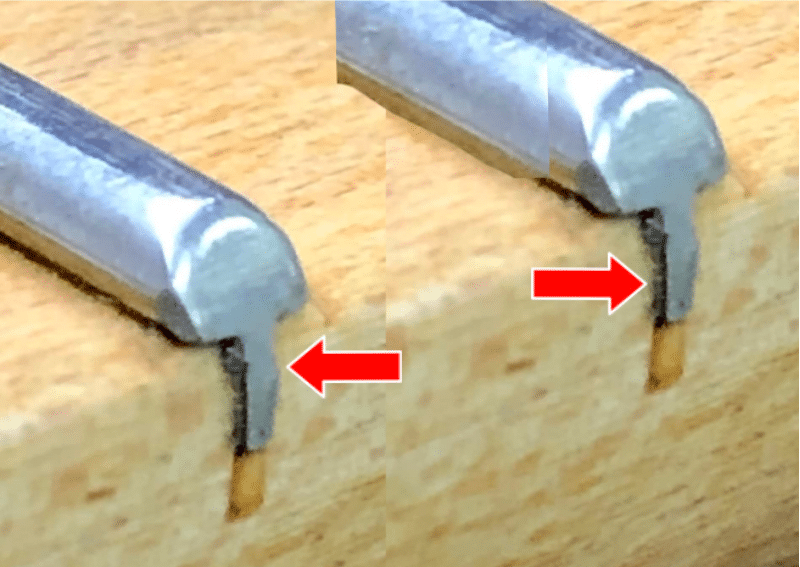
Loss of Crown Shape
Frets are typically crowned, meaning they have a rounded top. Over time, this crown can flatten, leading to a loss of precision in note intonation. The flatter the fret, the more difficult it becomes to achieve accurate tuning and clear sustain.
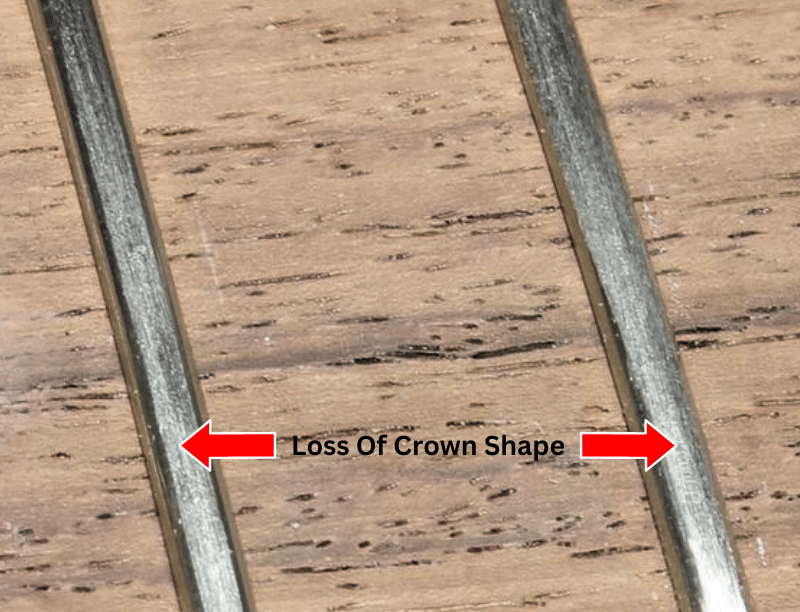
Changes in Tone
Worn frets can lead to noticeable changes in tone. The guitar may lose its brightness or sustain, or certain notes may sound dull or muted. These changes in tone are often subtle at first but can become more pronounced as fret wear progresses.
Difficulty Playing Certain Notes
Perhaps the most telling sign of fret wear is a change in how the guitar feels and plays. If you find it increasingly difficult to play cleanly, or if bends and vibratos feel uneven, it might be time to inspect your frets for wear.
Here’s a table that summarizes the stages of wear a fret goes through, how to find it, and what to do about it.
| Stage Of Wear | Visual Signs | Description | Recommended Action |
|---|---|---|---|
| No Wear | Smooth, even frets | Frets are in perfect condition, with no visible signs of wear or damage. | Enjoy playing; regular maintenance is sufficient. |
| Mild Wear | Slight grooves, minor discoloration | Early signs of wear, often in commonly played areas. No impact on playability. | Monitor closely; consider professional inspection. |
| Moderate Wear | Noticeable grooves, uneven frets | Wear is more pronounced, may begin to affect intonation and playability. | Consult a professional for potential leveling. |
| Severe Wear | Deep grooves, flat spots, sharp edges | Significant wear affecting sound, comfort, and playability. | Professional fret replacement or re-crowning likely needed. |
| Custom Wear | Varies based on player’s style | Wear patterns unique to specific playing techniques or custom frets. | Regular professional check-ups to align with playing style. |
There’s Always Hope For Worn-Down Frets!

Worn-down frets on a guitar are not the end of the road; they’re merely a pit stop on a musical journey. While fret wear may seem like a daunting issue, it’s a common challenge that many guitarists face, and there are proven solutions to restore the instrument to its former glory.
Fret restoration or replacement is not just for vintage or high-end guitars; it can be applied to any guitar, regardless of age or value. The key is finding a skilled professional who understands the unique characteristics of your instrument.
In some instances, it may be more cost-effective to deal with worn-out frets by replacing a bolt-on neck with a new pre-fretted one. High-quality, low-cost necks are available from a number of manufacturers, including Fender and Warmoth.
It’s essential to install a replacement neck that fits the original guitar’s specifications, like matching the scale length, etc.
Are You Qualified To Make Guitar Adjustments Or Modifications?
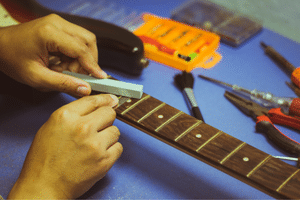
It’s great to work on your guitars, especially if you have a lot of them, but you should always be aware of your limitations.
Adjusting things like an electric guitar’s string height (action) or pickup height can be straightforward. Still, some adjustments require the proper training and experience, like adjusting a guitar’s truss rod.
When you doubt your ability to adjust, repair, or modify your guitar, it’s always best to bring it to a competent guitar technician or luthier (guitar designer & builder). You can permanently damage your guitar, and it might never play and sound right again!
Making modifications to your guitar can void its manufacturer’s warranty and cause permanent damage to the instrument. Certain modifications are irreversible, so you may be stuck with them, even if you desperately want to restore the guitar to its original condition!
I learned that the hard way over the years until I did a three-year apprenticeship in a guitar repair shop. Now I have my own home workshop with the proper training and equipment to safely maintain and repair all my instruments.
Remember: “When In Doubt, Send It Out!”
Professional Fret Services
When it comes to fret care, sometimes the expertise of a seasoned professional is the key to getting everything just right and fine-tuning your guitar to perfection. Let’s explore the world of professional fret services, where craftsmanship meets musicianship.
Fret Leveling
Fret leveling is the process of ensuring that all the frets are even across the fretboard. It’s like smoothing out the bumps on a road, creating a seamless playing experience. This service can eliminate buzzing, improve intonation, and enhance playability.
Fret Crowning
After leveling, frets often need crowning to restore their rounded shape. This process is like sculpting a masterpiece, carefully shaping each fret to its optimal form. Crowning ensures that the strings make precise contact with the frets, leading to clear and accurate notes.
Fret Replacement
Sometimes, frets are worn beyond repair and need replacement. This service is like a rebirth for your guitar, breathing new life into the instrument. A skilled technician can match the new frets to the original specifications, preserving the guitar’s character and feel.
Fret Polishing
Fret polishing is the finishing touch. It smooths out any remaining rough edges and gives the frets a shiny, appealing appearance. Polishing not only enhances the look but also improves the feel of the fretboard. Well-polished frets can make string bending and vibrato a lot easier and more enjoyable!
Custom Fret Work
For those seeking a unique touch, custom fretwork offers personalized solutions. Whether it’s a specific fret size, material, or a unique inlay design, custom work allows you to tailor the frets to your playing style and aesthetic preferences.
Should You Replace Frets On Vintage Guitars?
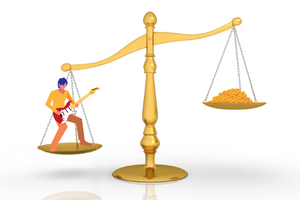
Vintage guitars are more than mere instruments; they are pieces of musical history, often carrying the legacy of legendary performances and iconic sounds. The decision to replace frets on such guitars is a complex one, fraught with considerations that go beyond playability.
Resale Value
One of the most significant concerns when considering re-fretting a vintage guitar is the potential impact on resale value. Vintage guitars often derive their value from their originality and authenticity.
Replacing frets can alter these characteristics, leading to a potential decrease in the instrument’s market value. Collectors and purists may view any modifications, even those intended to improve playability, as a deviation from the original state, thus diminishing the guitar’s appeal.
Playability Vs. Preservation
The decision to replace frets also involves a delicate balance between playability and preservation. While worn frets may hinder performance, the very wear itself might be a testament to the guitar’s history and use by previous musicians.
The choice between restoring playability and maintaining historical integrity is a deeply personal one, often guided by the owner’s intentions for the instrument.
Professional Consultation
If the decision to replace frets on a vintage guitar is being considered, it is imperative to consult with a luthier who specializes in vintage instruments. Such professionals can assess the specific condition of the guitar, provide insights into the potential impact on value, and offer tailored solutions that respect the instrument’s heritage.
Alternative Solutions
In some cases, alternative solutions such as fret leveling and re-crowning might be preferable to complete replacement. These less invasive procedures can improve playability without significantly altering the guitar’s original state.
Key Takeaways

Here are the most important point of this article.
- The way you play, including the use of hammer-ons, pull-offs, and vibrato, can significantly influence how quickly your frets wear down.
- Selecting the right strings can minimize fret wear, and understanding how different strings affect frets can lead to a more harmonious playing experience.
- Different fret materials have unique characteristics, and choosing the right one can align with your playing style and desired fret longevity.
- Regular cleaning and check-ups by a professional can extend the life of your frets and keep your guitar sounding its best.
- Recognizing the signs of fret wear, such as uneven frets and visible grooves, helps in timely maintenance.
Frequently Asked Questions

Here are some of the questions I get asked about guitar frets.
If your question does not appear here, please put it in the comments, and I will get right back to you with an answer.
What Is A Zero Fret?
A “zero fret” is a fret placed at the position where the nut would typically be found on a guitar. It serves as a guide for the strings, ensuring consistent height and spacing, and often results in improved intonation and sustain. It provides a uniform feel and tone across the entire fretboard.
What Fret Size Is Easiest To Play?
The “easiest” fret size to play often depends on the individual player’s preferences, playing style, and hand size.
Generally, medium-sized frets are considered a versatile choice, offering a comfortable balance between playability and control for many guitarists.
However, some may prefer larger jumbo frets for bending and vibrato, while others might find smaller vintage frets more comfortable for chord work.
Are Taller Frets Harder To Play?
Taller frets can provide more space between the fretboard and the strings, making techniques like bending easier for some players. However, they might feel more cumbersome to others, especially those used to smaller frets.
Why Are 6105 Frets So Popular?
The 6105 frets provide enough height for expressive play without feeling overly large, making them a versatile choice for various playing styles and genres. They offer a good balance between the larger jumbo frets, which are favored for bending and vibrato, and the smaller vintage frets, often preferred for chord work.
Can I Replace Frets Myself, Or Should I Always Consult A Professional?
While some experienced guitarists may attempt fret replacement themselves, it’s generally recommended to consult a professional luthier. They have the tools and expertise to ensure the job is done correctly, preserving the sound and value of your guitar.
How Do Scalloped Fretboards Affect Fret Wear?
Scalloped fretboards, where the wood between the frets is carved out, can change the way you play and potentially reduce fret wear. The design allows for lighter touch and may minimize pressure on the frets.
Can Fret Wear Affect My Guitar’s Intonation?
Yes, significant fret wear can affect intonation, causing notes to sound out of tune. Uneven or worn frets can alter the string’s contact point, leading to intonation issues.
What Are Partial Refrets, And When Are They Needed?
Partial refrets involve replacing only some of the frets, usually those that are most worn. They may be needed when wear is concentrated in specific areas, such as the first few frets.
How Much Does It Cost To Replace Frets?
The cost can vary widely based on factors such as the type of guitar, the material of the frets, the number of frets being replaced, and the expertise of the technician or luthier performing the work. On average, a complete re-fretting job for a standard guitar may range from $200 to $400, but high-end or vintage instruments could cost significantly more.
Final Thoughts

How long do guitar frets last? That’s the headlining question we’ve explored, and it’s clear that the answer is a combination of factors. From the materials used in the frets to the way you play and care for your guitar, the lifespan of your frets is a complex issue.
The life of your frets is a story written in every note you play. The choice of string types, playing techniques, and even the size and shape of the frets themselves all play a role that can lead to the subtle signs of wear to the need for professional fret services.
The impact of playing techniques like bending and vibrato all contribute to the unique voice of your instrument. The fret wear of each guitar player is written on the neck of their guitar like a fingerprint of their playing style!
Whether you’re a seasoned professional or just starting your musical journey, understanding fret wear requires attention, care, and a willingness to look beyond the surface. With the right approach, your frets can continue to function properly for years to come, and there’s always hope for guitars with worn-down frets, even those cherished entry-level instruments!

Check out this video on Sweetwater’s Plek Pro System!
The Plek process is a computer-controlled setup used to optimize the playability of a guitar’s neck. It scans the neck and fretboard to create a detailed profile, identifying uneven frets and other issues.
The Plek machine then precisely levels and crowns the frets, adjusts the nut slots, and performs other necessary adjustments, ensuring optimal string action, intonation, and overall playability.
What To Read Next ➡ Jumbo Vs Medium Jumbo Frets – Find The Perfect Size For You!
Tell Me What You Think

Please leave a comment below if you enjoyed this article, have any questions about guitar frets, or want to give your point of view. I will be happy to help you.
- What type and size frets do you prefer on your guitar? Why?
- How long do your frets last before they need maintenance or replacement?
- How do you keep your frets clean and functioning well?
- What else is on your mind?



If I am getting one for my kid, should i get a more inexpensive one now like the nickle and then get the stainless steel one next time? give him some time to do a little wear and tear and learn?
Hi, Marlee
Thank You for your question.
A guitar with nickel frets is fine for a beginning player, and pros use them, too. The stainless steel frets last a lot longer and feel smoother when doing string bends and finger vibrato, but they are not available on entry-level guitars.
Look into the Fender Squier series. They give great value for the price. ?
Rock On! ?
Frank ?
Thank you for your excellent articles about Guitar frets and specifically how long they may last. It is really informative and educational, and made me realize that I know nothing about these essential features. My inclination would be to engage an expert to carry out any repairs or even check to make sure a guitar is in working order and fit for purpose. Nevertheless, yours is a great expert guide, thank you for sharing.
Hi, Alan
Thank you for your comments!
Yes, if you are inexperienced, it’s best to have your guitar set up and repaired by a certified guitar tech. I recommend bringing your guitar to a luthier for fret repairs or replacement.
Rock On! 🤘
Frank 🎸
This blog post is a comprehensive guide to understanding how long guitar frets last, and it’s packed with valuable information for guitar enthusiasts. Frank does an excellent job breaking down the factors that affect fret longevity, such as material, size, playing techniques, and string types. The inclusion of tables and visuals makes it easy to grasp the concepts.
The insights provided on fret materials and sizes are particularly helpful for players making choices about their instruments. The explanations of playing techniques and their impact on fret wear offer practical advice for maintaining a guitar’s lifespan.
Overall, this post is a fantastic resource for anyone looking to extend the life of their guitar frets or make informed decisions when choosing new ones. Great job, Frank!
Hi, Hanna
I appreciate your comments!
Although the average player probably doesn’t have to concern themselves with fret wear, guitarists who play the same guitar for extended periods several times a day will eventually face this issue.
Pro players should consider buying their next electric guitar with stainless steel frets to mitigate the problem.
Frank